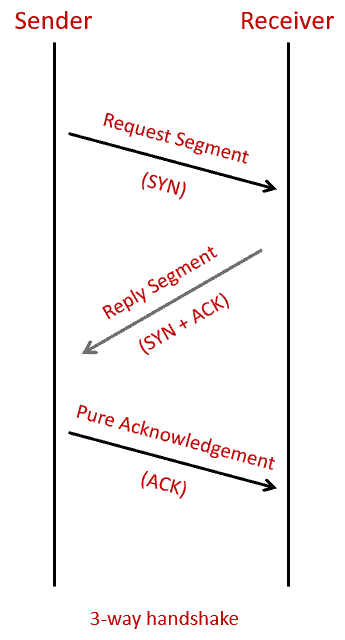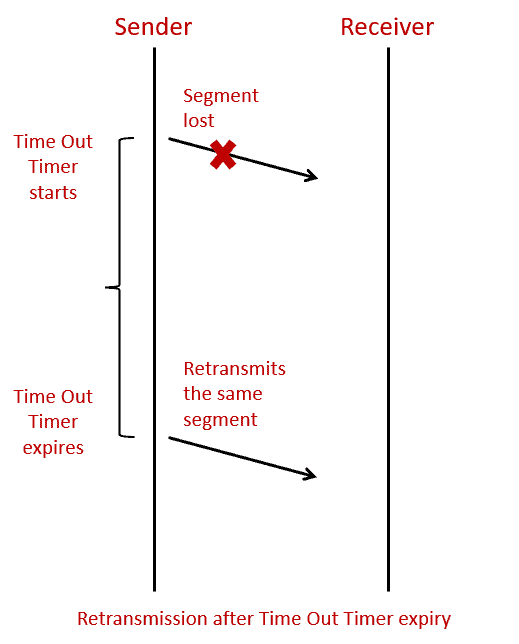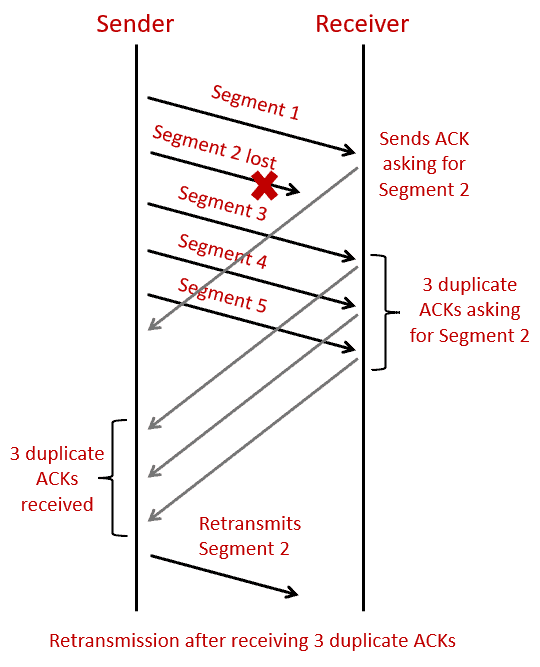1. TCP 重传概述
TCP(Transmission Control Protocol)是现代网络通信的基础协议之一,负责在应用程序和设备之间可靠地传输数据。为了保证数据传输的可靠性,TCP 引入了重传机制(Retransmission),用于在网络丢包时重新发送未被确认的数据。
本文将深入讲解 TCP 重传的原理、触发条件及其背后的技术逻辑,适合有一定网络编程经验的开发者参考。
2. TCP 重传的定义与原理
TCP 是一种面向连接的、可靠的、基于字节流的协议。它通过将数据拆分为TCP 段(Segment),封装在 IP 数据包中进行传输。
与 UDP 不同,TCP 会确保所有数据都能正确送达。当某个数据段在网络中丢失时,接收方不会收到该段,也就无法发送对应的 ACK(确认应答)。发送方通过两种机制检测到丢包并进行重传:
✅ 超时重传(Retransmission on Timeout)
✅ 快速重传(Fast Retransmission,基于三个重复 ACK)
在连接建立阶段,TCP 使用经典的三次握手建立连接,如下图所示:

连接建立后,发送方开始传输数据。如果某个段未被确认,就会触发重传机制。
3. 网络丢包的常见原因
网络传输过程中,数据包丢失是常见现象,主要原因包括:
- 信道噪声:随机丢包,可能由电磁干扰、信号衰减等引起
- 信道干扰:如 Wi-Fi 网络中多个设备竞争信道,造成结构化或周期性丢包
- 链路中断:如移动网络掉线,造成一段时间内全部丢包
- 冲突重传:在共享信道中使用 CSMA/CD 或 CSMA/CA 协议时,发生冲突导致丢包
- 拥塞丢包:路由器缓冲区溢出,导致丢弃新到达的数据包
- 实现错误:如网卡故障、驱动 bug、软件异常等
丢包率和模式取决于物理层和链路层的设计,不同网络环境表现差异较大。
4. TCP 重传的触发时机
TCP 重传主要在以下两种情况下发生:
4.1 超时重传(Retransmission After Timeout)
发送方每发送一个 TCP 段后,都会启动一个定时器。如果在定时器到期前没有收到 ACK,则认为该段丢失,触发重传。
流程如下:
- 发送段,启动定时器
- 收到 ACK → 停止定时器
- 定时器到期未收到 ACK → 重传段,重置定时器
示意图如下:

4.2 快速重传(Fast Retransmission)
当发送方连续收到三个重复的 ACK(Duplicate ACK)时,立即重传对应段,而不必等待定时器到期。
工作流程示例:
假设发送方发送了段 1~5,其中段 2 丢失,接收方的行为如下:
- 收到段 1 → 发送 ACK 2(期待段 2)
- 收到段 3 → 发送 ACK 2(重复 ACK)
- 收到段 4 → 发送 ACK 2(重复 ACK)
- 收到段 5 → 发送 ACK 2(重复 ACK)
发送方收到三个 ACK 2 后,立即重传段 2。
重传后接收方收到段 2,此时它已经收到了段 3~5,因此直接返回 ACK 6。
示意图如下:

⚠️ 注意:这种机制依赖于接收方的“冗余 ACK”行为,也被称为快速重传(Fast Retransmit)算法。
5. 总结
TCP 的重传机制是其可靠传输的核心保障之一。本文总结了以下关键点:
| 机制 | 触发条件 | 特点 |
|---|---|---|
| 超时重传 | 定时器到期 | 简单可靠,但响应慢 |
| 快速重传 | 收到三个重复 ACK | 反应快,但依赖接收端行为 |
通过这两种机制,TCP 能在不可靠的网络环境中实现可靠的数据传输,提升整体网络通信的稳定性和性能。
✅ 建议:在实际开发中,理解 TCP 重传机制有助于分析网络延迟、优化通信性能,尤其是在高丢包率或高延迟的网络环境下。
如需进一步了解 TCP 的流量控制和拥塞控制机制,可继续阅读相关文章。